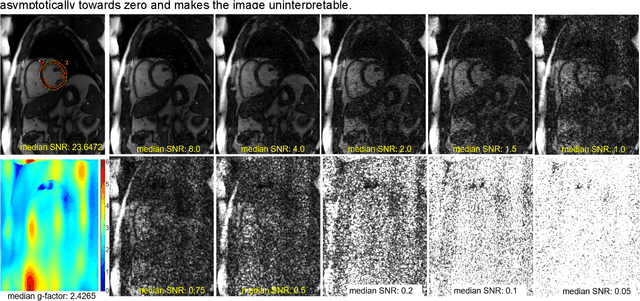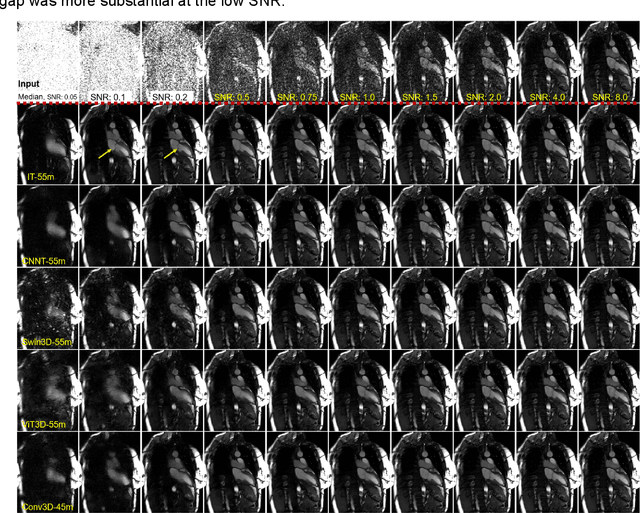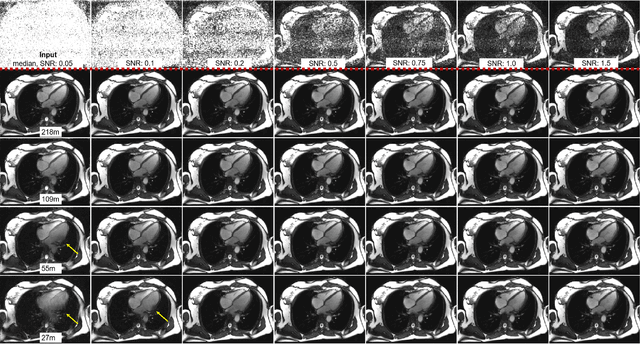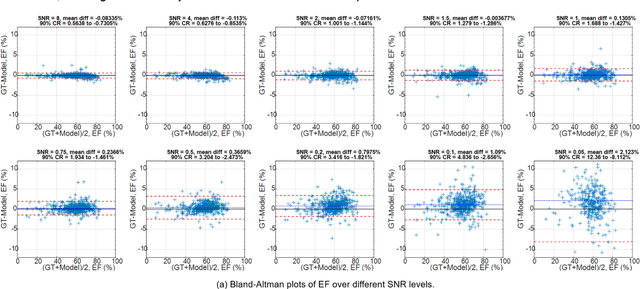Hui Xue
Generative Video Matting
Aug 11, 2025Abstract:Video matting has traditionally been limited by the lack of high-quality ground-truth data. Most existing video matting datasets provide only human-annotated imperfect alpha and foreground annotations, which must be composited to background images or videos during the training stage. Thus, the generalization capability of previous methods in real-world scenarios is typically poor. In this work, we propose to solve the problem from two perspectives. First, we emphasize the importance of large-scale pre-training by pursuing diverse synthetic and pseudo-labeled segmentation datasets. We also develop a scalable synthetic data generation pipeline that can render diverse human bodies and fine-grained hairs, yielding around 200 video clips with a 3-second duration for fine-tuning. Second, we introduce a novel video matting approach that can effectively leverage the rich priors from pre-trained video diffusion models. This architecture offers two key advantages. First, strong priors play a critical role in bridging the domain gap between synthetic and real-world scenes. Second, unlike most existing methods that process video matting frame-by-frame and use an independent decoder to aggregate temporal information, our model is inherently designed for video, ensuring strong temporal consistency. We provide a comprehensive quantitative evaluation across three benchmark datasets, demonstrating our approach's superior performance, and present comprehensive qualitative results in diverse real-world scenes, illustrating the strong generalization capability of our method. The code is available at https://github.com/aim-uofa/GVM.
Reviving DSP for Advanced Theorem Proving in the Era of Reasoning Models
Jun 13, 2025Abstract:Recent advancements, such as DeepSeek-Prover-V2-671B and Kimina-Prover-Preview-72B, demonstrate a prevailing trend in leveraging reinforcement learning (RL)-based large-scale training for automated theorem proving. Surprisingly, we discover that even without any training, careful neuro-symbolic coordination of existing off-the-shelf reasoning models and tactic step provers can achieve comparable performance. This paper introduces \textbf{DSP+}, an improved version of the Draft, Sketch, and Prove framework, featuring a \emph{fine-grained and integrated} neuro-symbolic enhancement for each phase: (1) In the draft phase, we prompt reasoning models to generate concise natural-language subgoals to benefit the sketch phase, removing thinking tokens and references to human-written proofs; (2) In the sketch phase, subgoals are autoformalized with hypotheses to benefit the proving phase, and sketch lines containing syntactic errors are masked according to predefined rules; (3) In the proving phase, we tightly integrate symbolic search methods like Aesop with step provers to establish proofs for the sketch subgoals. Experimental results show that, without any additional model training or fine-tuning, DSP+ solves 80.7\%, 32.8\%, and 24 out of 644 problems from miniF2F, ProofNet, and PutnamBench, respectively, while requiring fewer budgets compared to state-of-the-arts. DSP+ proves \texttt{imo\_2019\_p1}, an IMO problem in miniF2F that is not solved by any prior work. Additionally, DSP+ generates proof patterns comprehensible by human experts, facilitating the identification of formalization errors; For example, eight wrongly formalized statements in miniF2F are discovered. Our results highlight the potential of classical reasoning patterns besides the RL-based training. All components will be open-sourced.
Dynamic Mixture of Curriculum LoRA Experts for Continual Multimodal Instruction Tuning
Jun 13, 2025Abstract:Continual multimodal instruction tuning is crucial for adapting Multimodal Large Language Models (MLLMs) to evolving tasks. However, most existing methods adopt a fixed architecture, struggling with adapting to new tasks due to static model capacity. We propose to evolve the architecture under parameter budgets for dynamic task adaptation, which remains unexplored and imposes two challenges: 1) task architecture conflict, where different tasks require varying layer-wise adaptations, and 2) modality imbalance, where different tasks rely unevenly on modalities, leading to unbalanced updates. To address these challenges, we propose a novel Dynamic Mixture of Curriculum LoRA Experts (D-MoLE) method, which automatically evolves MLLM's architecture with controlled parameter budgets to continually adapt to new tasks while retaining previously learned knowledge. Specifically, we propose a dynamic layer-wise expert allocator, which automatically allocates LoRA experts across layers to resolve architecture conflicts, and routes instructions layer-wisely to facilitate knowledge sharing among experts. Then, we propose a gradient-based inter-modal continual curriculum, which adjusts the update ratio of each module in MLLM based on the difficulty of each modality within the task to alleviate the modality imbalance problem. Extensive experiments show that D-MoLE significantly outperforms state-of-the-art baselines, achieving a 15% average improvement over the best baseline. To the best of our knowledge, this is the first study of continual learning for MLLMs from an architectural perspective.
Score-based Generative Modeling for Conditional Independence Testing
May 29, 2025Abstract:Determining conditional independence (CI) relationships between random variables is a fundamental yet challenging task in machine learning and statistics, especially in high-dimensional settings. Existing generative model-based CI testing methods, such as those utilizing generative adversarial networks (GANs), often struggle with undesirable modeling of conditional distributions and training instability, resulting in subpar performance. To address these issues, we propose a novel CI testing method via score-based generative modeling, which achieves precise Type I error control and strong testing power. Concretely, we first employ a sliced conditional score matching scheme to accurately estimate conditional score and use Langevin dynamics conditional sampling to generate null hypothesis samples, ensuring precise Type I error control. Then, we incorporate a goodness-of-fit stage into the method to verify generated samples and enhance interpretability in practice. We theoretically establish the error bound of conditional distributions modeled by score-based generative models and prove the validity of our CI tests. Extensive experiments on both synthetic and real-world datasets show that our method significantly outperforms existing state-of-the-art methods, providing a promising way to revitalize generative model-based CI testing.
Towards the Resistance of Neural Network Watermarking to Fine-tuning
May 02, 2025



Abstract:This paper proves a new watermarking method to embed the ownership information into a deep neural network (DNN), which is robust to fine-tuning. Specifically, we prove that when the input feature of a convolutional layer only contains low-frequency components, specific frequency components of the convolutional filter will not be changed by gradient descent during the fine-tuning process, where we propose a revised Fourier transform to extract frequency components from the convolutional filter. Additionally, we also prove that these frequency components are equivariant to weight scaling and weight permutations. In this way, we design a watermark module to encode the watermark information to specific frequency components in a convolutional filter. Preliminary experiments demonstrate the effectiveness of our method.
Imaging Transformer for MRI Denoising: a Scalable Model Architecture that enables SNR << 1 Imaging
Apr 13, 2025



Abstract:Purpose: To propose a flexible and scalable imaging transformer (IT) architecture with three attention modules for multi-dimensional imaging data and apply it to MRI denoising with very low input SNR. Methods: Three independent attention modules were developed: spatial local, spatial global, and frame attentions. They capture long-range signal correlation and bring back the locality of information in images. An attention-cell-block design processes 5D tensors ([B, C, F, H, W]) for 2D, 2D+T, and 3D image data. A High Resolution (HRNet) backbone was built to hold IT blocks. Training dataset consists of 206,677 cine series and test datasets had 7,267 series. Ten input SNR levels from 0.05 to 8.0 were tested. IT models were compared to seven convolutional and transformer baselines. To test scalability, four IT models 27m to 218m parameters were trained. Two senior cardiologists reviewed IT model outputs from which the EF was measured and compared against the ground-truth. Results: IT models significantly outperformed other models over the tested SNR levels. The performance gap was most prominent at low SNR levels. The IT-218m model had the highest SSIM and PSNR, restoring good image quality and anatomical details even at SNR 0.2. Two experts agreed at this SNR or above, the IT model output gave the same clinical interpretation as the ground-truth. The model produced images that had accurate EF measurements compared to ground-truth values. Conclusions: Imaging transformer model offers strong performance, scalability, and versatility for MR denoising. It recovers image quality suitable for confident clinical reading and accurate EF measurement, even at very low input SNR of 0.2.
AIR: A Systematic Analysis of Annotations, Instructions, and Response Pairs in Preference Dataset
Apr 04, 2025Abstract:Preference learning is critical for aligning large language models (LLMs) with human values, yet its success hinges on high-quality datasets comprising three core components: Preference \textbf{A}nnotations, \textbf{I}nstructions, and \textbf{R}esponse Pairs. Current approaches conflate these components, obscuring their individual impacts and hindering systematic optimization. In this work, we propose \textbf{AIR}, a component-wise analysis framework that systematically isolates and optimizes each component while evaluating their synergistic effects. Through rigorous experimentation, AIR reveals actionable principles: annotation simplicity (point-wise generative scoring), instruction inference stability (variance-based filtering across LLMs), and response pair quality (moderate margins + high absolute scores). When combined, these principles yield +5.3 average gains over baseline method, even with only 14k high-quality pairs. Our work shifts preference dataset design from ad hoc scaling to component-aware optimization, offering a blueprint for efficient, reproducible alignment.
Mirage in the Eyes: Hallucination Attack on Multi-modal Large Language Models with Only Attention Sink
Jan 25, 2025



Abstract:Fusing visual understanding into language generation, Multi-modal Large Language Models (MLLMs) are revolutionizing visual-language applications. Yet, these models are often plagued by the hallucination problem, which involves generating inaccurate objects, attributes, and relationships that do not match the visual content. In this work, we delve into the internal attention mechanisms of MLLMs to reveal the underlying causes of hallucination, exposing the inherent vulnerabilities in the instruction-tuning process. We propose a novel hallucination attack against MLLMs that exploits attention sink behaviors to trigger hallucinated content with minimal image-text relevance, posing a significant threat to critical downstream applications. Distinguished from previous adversarial methods that rely on fixed patterns, our approach generates dynamic, effective, and highly transferable visual adversarial inputs, without sacrificing the quality of model responses. Comprehensive experiments on 6 prominent MLLMs demonstrate the efficacy of our attack in compromising black-box MLLMs even with extensive mitigating mechanisms, as well as the promising results against cutting-edge commercial APIs, such as GPT-4o and Gemini 1.5. Our code is available at https://huggingface.co/RachelHGF/Mirage-in-the-Eyes.
Jailbreaking Multimodal Large Language Models via Shuffle Inconsistency
Jan 09, 2025



Abstract:Multimodal Large Language Models (MLLMs) have achieved impressive performance and have been put into practical use in commercial applications, but they still have potential safety mechanism vulnerabilities. Jailbreak attacks are red teaming methods that aim to bypass safety mechanisms and discover MLLMs' potential risks. Existing MLLMs' jailbreak methods often bypass the model's safety mechanism through complex optimization methods or carefully designed image and text prompts. Despite achieving some progress, they have a low attack success rate on commercial closed-source MLLMs. Unlike previous research, we empirically find that there exists a Shuffle Inconsistency between MLLMs' comprehension ability and safety ability for the shuffled harmful instruction. That is, from the perspective of comprehension ability, MLLMs can understand the shuffled harmful text-image instructions well. However, they can be easily bypassed by the shuffled harmful instructions from the perspective of safety ability, leading to harmful responses. Then we innovatively propose a text-image jailbreak attack named SI-Attack. Specifically, to fully utilize the Shuffle Inconsistency and overcome the shuffle randomness, we apply a query-based black-box optimization method to select the most harmful shuffled inputs based on the feedback of the toxic judge model. A series of experiments show that SI-Attack can improve the attack's performance on three benchmarks. In particular, SI-Attack can obviously improve the attack success rate for commercial MLLMs such as GPT-4o or Claude-3.5-Sonnet.
KAnoCLIP: Zero-Shot Anomaly Detection through Knowledge-Driven Prompt Learning and Enhanced Cross-Modal Integration
Jan 07, 2025



Abstract:Zero-shot anomaly detection (ZSAD) identifies anomalies without needing training samples from the target dataset, essential for scenarios with privacy concerns or limited data. Vision-language models like CLIP show potential in ZSAD but have limitations: relying on manually crafted fixed textual descriptions or anomaly prompts is time-consuming and prone to semantic ambiguity, and CLIP struggles with pixel-level anomaly segmentation, focusing more on global semantics than local details. To address these limitations, We introduce KAnoCLIP, a novel ZSAD framework that leverages vision-language models. KAnoCLIP combines general knowledge from a Large Language Model (GPT-3.5) and fine-grained, image-specific knowledge from a Visual Question Answering system (Llama3) via Knowledge-Driven Prompt Learning (KnPL). KnPL uses a knowledge-driven (KD) loss function to create learnable anomaly prompts, removing the need for fixed text prompts and enhancing generalization. KAnoCLIP includes the CLIP visual encoder with V-V attention (CLIP-VV), Bi-Directional Cross-Attention for Multi-Level Cross-Modal Interaction (Bi-CMCI), and Conv-Adapter. These components preserve local visual semantics, improve local cross-modal fusion, and align global visual features with textual information, enhancing pixel-level anomaly detection. KAnoCLIP achieves state-of-the-art performance in ZSAD across 12 industrial and medical datasets, demonstrating superior generalization compared to existing methods.
 Add to Chrome
Add to Chrome Add to Firefox
Add to Firefox Add to Edge
Add to Edge